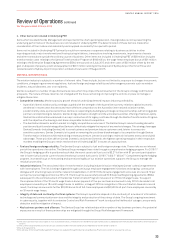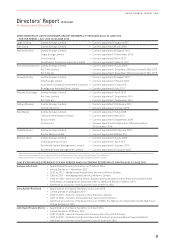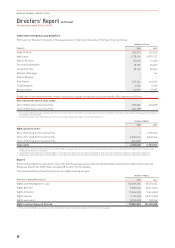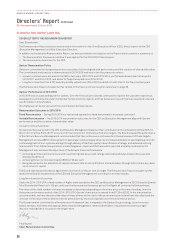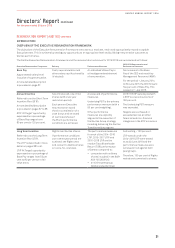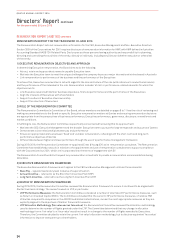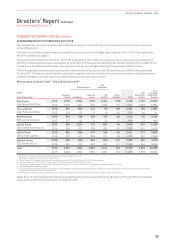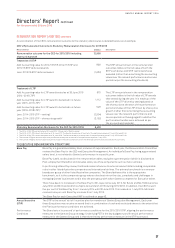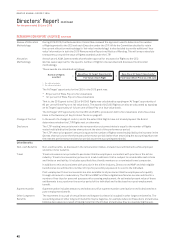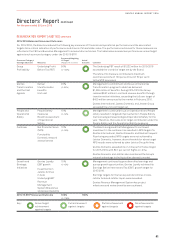Qantas 2016 Annual Report Download - page 34
Download and view the complete annual report
Please find page 34 of the 2016 Qantas annual report below. You can navigate through the pages in the report by either clicking on the pages listed below, or by using the keyword search tool below to find specific information within the annual report.
Directors’ Report continued
For the year ended 30 June 2016
REMUNERATION REPORT (AUDITED) CONTINUED
REMUNERATION OUTCOMES FOR THE CEO IN 2015/2016
The remuneration outcomes for the CEO in 2015/2016 are
detailed in the following table.
The CEO’s variable pay outcome for 2015/2016 was:
–An award under the 2015/16 STIP comprising a cash bonus
of$3,264,000 and $1,632,000 worth of shares with a two year
restriction period
–100 per cent of the 2014–2016 LTIP Rights awarded to the CEO
vested and converted to 2,151,000 shares. At the start of the
LTIP performance period (1 July 2013) this number of shares
would have been valued at $2,904,000 (2,151,000 shares at
$1.35 share price). Given the 109 per cent increase in share
price (to $2.82 on 30 June 2016), the value of these shares has
appreciated by $3,162,000
These outcomes are aligned with the CEO’s and Qantas’
performance during 2015/2016 as well as being aligned with
Qantas’ longer-term performance. This link between pay and
performance is detailed below.
CEO Remuneration
Outcomes1
2016
$’000
2015
$’000
2016 ‘At
Target’ Pay
$’000
2016 as a
Percentage
of ‘At Target’
Pay
%
Base Pay (cash) 2,106 2,000 2,125 n/a
STIP – cash
bonus 3,264 1,904 1,700 192
STIP – restricted
shares21,632 952 850 192
LTIP – vesting32,904 2,353 1,7004171
Other (108) 112 –n/a
Total –
excluding share
price growth 9,798 7,321 6,375 154
LTIP – share
price growth53,162 4,563
Total –
including share
price growth 12,960 11,884
1 Detail of non-statutory remuneration methodology is explained on pages 38 and 40.
2 The number of restricted shares to be awarded will be determined based on the seven
calendar day Volume Weighted Average Share Price as at 31 August 2016.
3 LTIP vesting at 100 per cent valued at the start of the performance period (1 July 2013)
when the share price was $1.35.
4 The ‘At Target’ Pay for LTIP is set based on a fair value allocation methodology for LTIP
awards. The ‘At Target’ value applying a face value methodology for the 2014–2016 LTIP
would be $2,904,000.
5. Increase in the value of the vested shares over the performance period (1 July 2013 to
30June 2016).
Link Between CEO Pay and Performance
The CEO’s pay is linked to Qantas’ performance through the
performance measures under both the annual incentive and the
long-term incentive. At Qantas, annual incentives are only paid
in years when, in the Board’s view, the business and Executives
have performed well. Similarly, long-term incentives only vest
where financial performance has been strong and challenging
three year performance measures are met. This is demonstrated
in the CEO Remuneration Outcomes History graph on page 33.
Base Pay
The CEO’s Base Pay has been frozen since 1 July 2011 and
he did not receive an increase to Base Pay during 2015/2016.
Additionally, the CEO forwent five per cent of his Base Pay from
1January 2014 until 30 June 2015. This ceased on 1 July 2015.
Base Pay (cash) is Base Pay of $2,125,000 less superannuation
contributions of $19,308. Base Pay is benchmarked against
external market data including comparable roles in other listed
Australian companies and international airlines.
Annual Incentive – 2015/16 STIP Outcome
In determining outcomes under the STIP, the Board assesses
performance against financial, safety and other key business
measures as part of a balanced scorecard, as outlined on page
41.
The STIP award paid to the CEO for 2015/2016 was determined
primarily by Management’s delivery of the record financial
results as well as meeting or exceeding non-financial measures
that comprise the STIP scorecard. The Board assessed the CEO
and Management’s significant contribution to these results,
inparticular:
–Delivery in 2015/2016 of $557 million cost savings and
revenue enhancements driven by the Qantas Transformation
program – in excess of the targeted $450 million of benefits
from the program in the financial year. This contributed to
the Group’s ex-fuel unit cost reducing by three per cent in
the financial year
–Management’s prudent approach to fuel hedging and active
restructuring of hedged positions, as well as the Qantas
Transformation program, enabled a $664 million reduction
in year-on-year underlying fuel expense. Qantas’ approach
to fuel hedging continued to provide a higher participation in
falling fuel prices compared to many of our competitors
–Continued investment in the customer (better product
and more training for our people), which delivered record
customer advocacy, or Net Promoter Scores
–Growth of earnings in core domestic airline businesses
(Qantas and Jetstar), achieving another year of margin
expansion compared to domestic competitors in both
premium and low-cost customer segments. Core competitive
advantages in domestic Australia including Qantas’ network
and frequency, as well as customer product premium, and
Jetstar’s cost and scale advantage were all either maintained
or enhanced
–Pursuit of growth opportunities in international markets, via
787 aircraft in Jetstar International, growth of Jetstar Airlines
in Asia, the commencement of regional Jetstar services
in New Zealand and new airline partnerships supporting
network growth at Qantas International
–Increased aircraft utilisation which allowed growth of
passenger revenue using existing Group aircraft
–Continued growth of diversified earnings at Qantas Loyalty,
with core Qantas Frequent Flyer program and new adjacent
businesses (Qantas Cash, Aquire) performing well and
theexpansion into health insurance with the launch of
QantasAssure
32
QANTAS ANNUAL REPORT 2016



